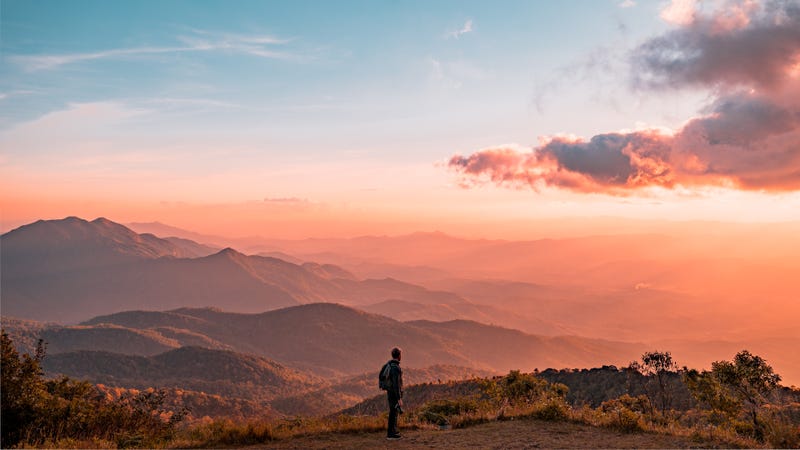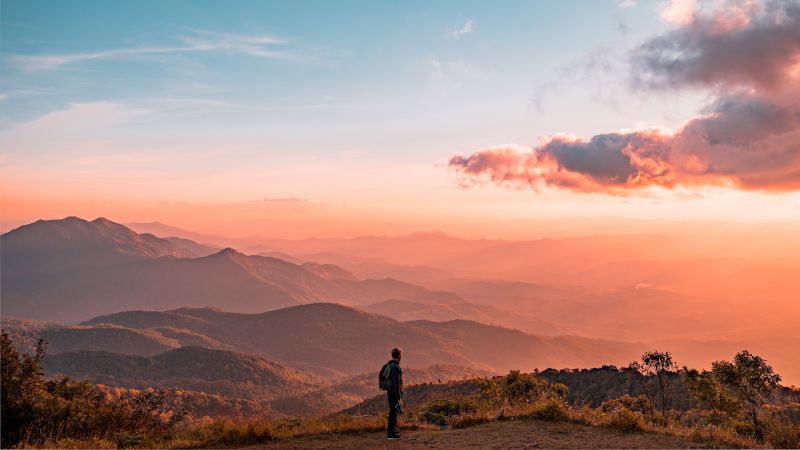
There’s no bad time to go for a hike, but this is the best time of year to go for a hike.
We’ve covered a ton of gear over the years to make everything from inner-city arboretum treks to backcountry adventures safer and more enjoyable, so consider this your hiking starter kit. Just add trails.
Water, water, water. You should never go for a hike of basically any length without bringing along some water, and that goes double if you’re hiking anywhere remotely…uh, remote.
Advertisement
Obviously, any water bottle will do, and I’m not going to tell you otherwise, but Hydro Flask’s are popular for a reason: they look great, they’re durable, and they keep your drink cold for hours on end. Right now, they’re selling limited edition bottlesin collaboration with the National Parks Foundation, but you can find an endless array of colors and sizes (183,456 possible combinations to be exact, as of this writing) on their site.
If Hydro Flasks are a bit out of your price range, you can never go wrong with a nigh-indestructible (and reader-favorite) Nalgene. They won’t keep your drink as cold as vacuum insulated stainless steel bottles, but they’re BPA free, easy to clean, and very affordable.
If you know you’ll be hiking alongside a body of water, it might not be a bad idea to keep a portable water filter in your bag, just in case you end up hiking a little further than you intended, and need some extra hydration. I’ve personally sipped from a random creek with the Sawyer PointOne filter, and I didn’t die!
You can wear basically anything you want on a hike, but we’ve got a few suggestions to make your walk more comfortable and enjoyable. Here they are, working from the head down:
Advertisement
Sunscreen is important. Please wear sunscreen. But the best sun protection is keeping the sun’s rays from ever actually reaching your skin, and we’ve rounded up some of our favorite hats designed just for this purpose.
Likewise, if you’re hiking in an area without much shade, a sun shirt can block those harmful UV rays, and yes, still be cool and comfortable.
You won’t want to leave without a good raincoat if there’s any chance of moisture in the forecast. You can check out our readers’ six favorites here, but my personal advice? Find one with a stiff hood brim.
If it’s warm outside and you aren’t dealing with too much underbrush, we’ve yet to try any shorts that we like more than Olivers’ All Over Short. They’re made from nylon and spandex like most athletic shorts, but they look nice enough that you could wear them straight out to a nice-ish dinner once you get back to the trailhead.
But if you prefer full-length pants, your search should begin and end with Coalatree’s Trailhead pants. They’re waterproof, moisture-wicking, anti-microbial, stretchy, comfortable, and lightweight. That’s literally everything you could want on a pair of hiking pants.
Socks! You probably don’t give them much thought in your day-to-day life, but finding the right pair is critical if you’re going on an extended hike, especially if you’ll be dealing with any undergrowth. Our Heather Balogh Rochfort rounded up some great sock options, and her list is led by our readers’ favorite brand: Darn Tough. They’re spendier than you’re probably used to (as merino wool clothes tend to be), but it’s worth investing in at least a couple of pairs.
And last but certainly not least, your feet will thank you for a great pair of hiking boots, and we recommend the Danner Mountain 600s. From our review:
We had known Danner was going to be incorporating these Vibram soles for quite a while, and it was absolutely worth the wait from both a support and aesthetic standpoint. The more mellow lines of the Vibrams meld with Danner’s great details to form one of the best-looking hikers around, and in a lot of great colorways to boot (get it?).
But our favorite feature of the 600s, which doesn’t appear to even be noted on its listings, is the tongue. Connected to the sides of the shoe with a stretchy membrane, the tongue is soft and has a huge amount of give, so while the excellent laces keep the 600s feeling very secure, the pressure on the top of your foot is basically zero. It’s a small touch that makes a huge difference.
You’re clothed. You’ve got water. You’ve honestly got all you need for at least a short hike. But this gear can help you venture further, enjoy a picnic at the end of the trail, and more.
Advertisement
First, we recommend Matador’s Pocket Blanket, which—surprise—can pack down to fit in your pocket. Even if you aren’t enjoying a full-on picnic, it can be nice to sit on something that isn’t dirt or a rock when you need to take a breather.
If you’re traveling with a friend and are worried about getting separated, GoTenna pocket antennas let you send text messages and GPS coordinates to each other over a distance of several miles, even if neither of you have cell reception. Sorry, they won’t let you transmit stories to Instagram, but that’s probably for the best.
If you’re hiking with your infant, on the other hand, you’ll obviously want to stay as close together as possible. Your kid and your back will both thank you for investing in one of our favorite outdoor kid carriers.
There’s no better finish line for a hike than a secluded body of water that you can swim in, but you’ll want to bring along a towel to dry off before you head back to the trail. Nomadix’s 1-pound towels are easy to lug into the backcountry, and they’re even made from recycled water bottles, so you can feel good about buying them.
And finally, we recommend clipping a a HEROCLIP to your belt loop or bag, just in case. Unlike a traditional carabiner, you can use HEROCLIP to hang bags, wet clothes, water bottles, and anything else from the nearest available tree branch.
Hiking on a popular trail with lots of people is a pretty low-risk activity. Venturing into the backcountry on your own though opens up the possibility of all sorts of unpleasant emergencies that you’ll want to be prepared for.
Advertisement
If you get caught out at night, you’ll be glad you brought a LuminAid inflatable lantern. It packs down and hangs off your bag during the day, soaking up the sun’s energy with a built-in solar panel, and then uses its battery to run an LED lantern at night. Some models even have a USB port that can give your phone an emergency charge, if you need to call for help.
Lanterns are useful if you’re packing it in for the night, but if you’re trying to find your way around, you’ll want a flashlight, and none are more impressive than Hydralight. To power Hydralight, you dip its hydrogen fuel cell into water (fresh water, salt water, clean water, dirty water, urine…it doesn’t discriminate) for 10-12 seconds, which through the magic of science translates into 100 hours of continuous light. At under $20, it’s worth every penny.
If you want to keep your hands free, a good headlamp might be a better option, and we’ve never tried one as comfortable as BioLite’s HeadLamp 330. You can even add on a light-diffusing sack that turns it into a lantern.
The ability to make a fire is pretty much camping 101, and it’s a lot easier if you pack the right matches. UCO’s Stormproof matches work in the wind, the rain, and even under water, so even pyrotechnic newbies will be able to get their kindling going.













